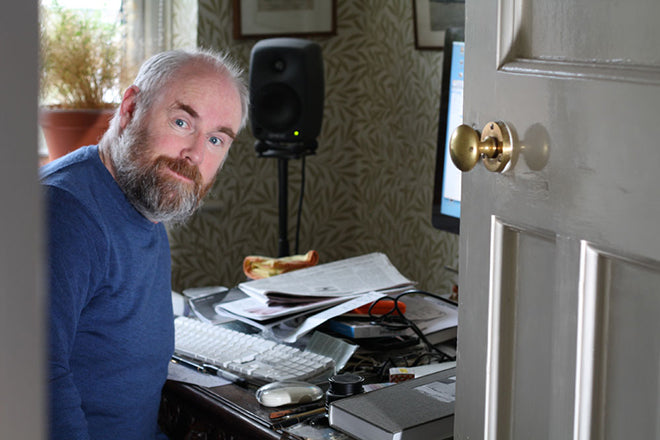
Richard West, Source
We start this week in Belfast, home of photography magazine Source. Launched in 1993 to promote photography in Northern Ireland, the magazine has grown an eight-page black and white format into an 88-page quarterly. Its latest advance is a redesign by Studio Rob van Hoesel. We spoke to editor Richard West about his life in magazines, the redesign, and his week ahead.
Tell us about your typical Monday journey to work
I roll out of bed, have breakfast with my family and then make a cup of tea and go up to the small box room that is my office to start work.
Describe the state of your desk and what you can see in your office
My desk gets increasingly cluttered and messy as I work towards a deadline. This morning I can see pens, old postcards, recently arrived books, hard drives, cables and a stack of random paper and magazines that have all accumulated in the last month. They should all be tidied away but may have important notes written on them. On the floor there are stacks of cardboard boxes that I collect to send books out to reviewers.
In front of me is a small brass paperweight that has the body and ears of a rabbit but the tail and posture of a squirrel, possibly from a time when the squirrel/rabbit distinction was not so clear cut as it is today.
Which magazine do you first remember?
I got a copy of Aeromodeller in a newsagent as a small boy. There was a picture of an old biplane on the cover and a large fold-out plan inside for how to make it. I attempted this over a summer holiday. The result looked nice but I had limited success in making it fly.
Which magazine matters to you the most right now?
I have a daily diet of the TLS and Private Eye which give me a view of the ever stimulating output of publishers and our dismal and fascinating political times. From time to time I will buy other magazines like the New Yorker, The Wire and Sight and Sound. I just got a copy of a magazine called Fireflies, each issue is about a film maker and this one is about Pedro Costa.
Can you describe your magazine in three words?
Straight, pointy and clear.
Source has gone through a redesign for this issue, can you tell us a bit more about that?
We have a new strapline ‘Thinking through photography’ that says what we want the magazine to do: to examine photography and its histories but also to be outward looking. So we review exhibitions and photobooks but we're also interested in what's going on in the world.
To give you an example, this issue is about privacy and they are much stricter about it in France, so we’ve spoken to the picture editor of French news magazine L’Obs to see if she has any restriction on what pictures she can publish (above).
There is also a long interview with artist Gillian Wearing (along with 10 pages of her pictures, above) and there are nice connections between these two features that we couldn't have predicted before we put them together.
What do you think about the old adage ‘a picture tells a thousand words’, and what does this mean for making a photography magazine?
Photographs are inscrutable but their mystery is not used up by the words that describe them. Our basic formula is to find photographs that are worth our attention and then commission someone to write about them in a way that will make that encounter deeper and more worthwhile.
Then again, in some cases what you can say about a photograph is more interesting than the picture itself; the legal debate about invasion of privacy is more interesting than a picture of a woman eating a sandwich on the Tube.
Can you tell us about the magazine scene in Northern Ireland right now?
I can’t tell you much about that but I do notice there are a lot of new photography magazines starting up. Notable examples are Notes in Scotland and Junior in Dublin and we often come across (and review) new titles. It must be a fertile time for photography and it's encouraging that print magazines are still an attractive way to publish new work.
What’s going to be the highlight of the week for you?
A trip to the National Archives to look at pictures produced by the chemical weapons establishment for a report on the effects of drug consumption.
What are you doing after this chat?
Every day I get books in the post which I photograph and put on our twitter feed. The postman's just been, so I'll go and see what he's brought me.










